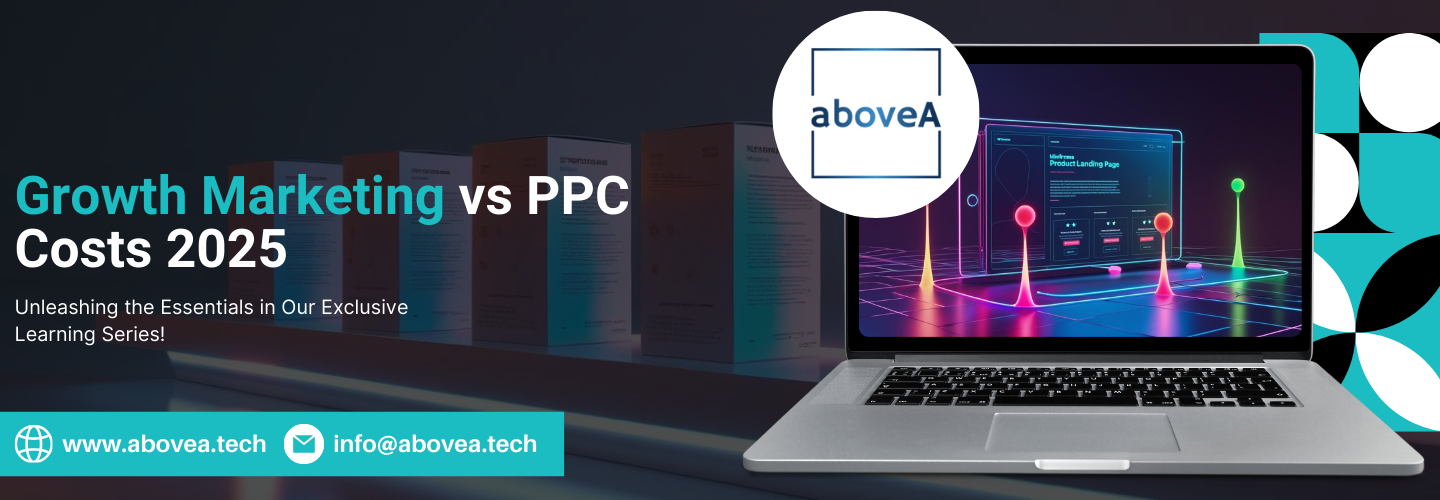
The Real Cost of Growth Marketing vs PPC in 2025
The real cost of growth marketing vs PPC in 2025 is a question every business faces. Growth marketing builds long-term value, while PPC offers instant visibility but at a higher ongoing price. This article breaks down both approaches, compares costs, and examines ROI. You’ll see pricing models, hidden expenses, and case studies across industries. We’ll also cover future trends, agency comparisons, and which option fits different business sizes. By the end, you’ll know exactly how much growth marketing and PPC cost in 2025, and which strategy delivers better returns for your goals.
What Is Growth Marketing?
Growth marketing in 2025 is a strategy focused on long-term customer acquisition, retention, and revenue growth. Unlike traditional marketing, which often focuses solely on awareness, growth marketing leverages data, testing, and full-funnel tactics to maximize lifetime value.
A growth marketing strategy blends SEO, email automation, social media, conversion rate optimization, and customer behavior analysis. The goal is not just to get clicks but to build lasting relationships. This approach means costs are often higher in the beginning. Businesses invest in content, analytics tools, and testing. But over time, growth marketing produces compounding results that reduce the cost per acquisition.
For example, an ecommerce store using growth marketing may spend $8,000 on content, landing page design, and automation tools in the first three months. In return, traffic, email subscribers, and conversions grow steadily. After six months, the same content continues generating leads at little additional cost. This creates a lower long-term cost per lead compared to paid ads.
Growth marketing is also adaptable. By analyzing data, businesses shift focus to the channels that perform best. If SEO drives high-value leads, more resources are allocated to it. If email nurtures repeat buyers, campaigns expand. This constant optimization increases ROI.
Growth marketing costs in 2025 vary by business size, industry, and strategy. Small businesses may spend $3,000–$7,000 per month, while mid-size companies spend $10,000–$25,000. Enterprise-level growth marketing campaigns can exceed $50,000/month when scaling across global markets.
In short, growth marketing is an investment in sustainable growth. It prioritizes data-driven decisions and compounding returns, making it a strong alternative to PPC for businesses thinking long term.
What Is PPC in 2025?
PPC in 2025 is paid advertising where businesses pay for every click their ad receives. Platforms like Google Ads, Meta Ads, TikTok Ads, and LinkedIn dominate the space. Unlike growth marketing, PPC delivers instant visibility. A campaign can generate clicks within hours of launch, but results stop the moment spending ends.
The cost of PPC in 2025 continues to rise. According to WordStream, average cost-per-click (CPC) ranges from $1–$4 in low-competition industries but exceeds $20 in sectors like finance, legal, or B2B software. Some competitive keywords even reach $50+ per click, pushing businesses to manage budgets carefully.
PPC pricing depends on several models:
- Cost per click (CPC): Pay only for each visitor.
- Cost per mille (CPM): Pay per 1,000 impressions.
- Cost per acquisition (CPA): Pay for a lead or conversion.
These models allow flexibility, but they can quickly increase expenses if campaigns are not optimized.
An e-commerce brand might spend $5,000 in one month on Google Shopping ads. If the conversion rate is 2%, only 100 sales result. Unless margins are high, ROI becomes challenging. By contrast, growth marketing may take longer to build momentum but lowers acquisition costs over time.
PPC management in 2025 also carries hidden fees. Agencies typically charge 10–20% of ad spend as a management fee, while freelancers charge flat retainers ranging from $1,000–$5,000 monthly. Businesses must budget for both ad spend and management costs.
In summary, PPC is best for businesses seeking fast results, seasonal campaigns, or immediate market entry. But in 2025, rising CPCs and reliance on constant spending make PPC a short-term strategy compared to growth marketing’s compounding ROI.
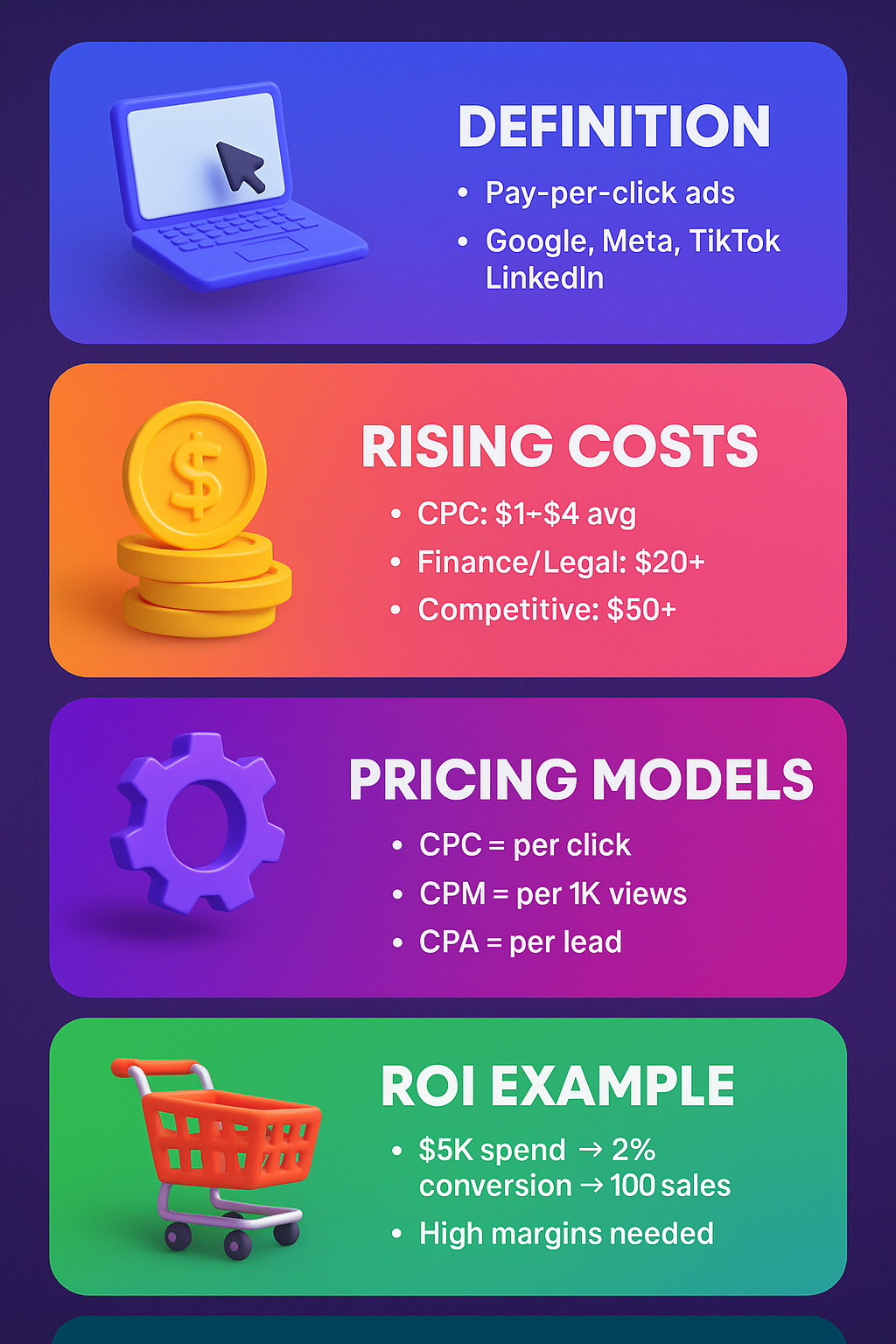
Cost Breakdown: Growth Marketing vs PPC
The real cost of growth marketing vs PPC in 2025 depends on goals, industry, and budget. Growth marketing requires higher upfront investment but compounds over time. PPC offers instant visibility but needs constant spending. Comparing both reveals how businesses should allocate marketing dollars.
Growth marketing costs include:
Content creation (blogs, videos, landing pages)
SEO tools and automation platforms
Data analytics and testing
Agency retainers or in-house teams
These costs can range from $3,000/month for small businesses to $50,000+/month for global campaigns. While high at first, growth marketing lowers customer acquisition cost (CAC) over time as organic traffic, referrals, and conversions increase.
PPC costs include:
Ad spend on Google, Meta, TikTok, or LinkedIn
Management fees (10–20% of ad spend for agencies)
Testing creative, A/B ads, and retargeting campaigns
A small business might spend $2,500/month, while enterprise brands exceed $100,000+ monthly across multiple platforms. Unlike growth marketing, PPC costs reset every month – stop paying, and traffic disappears.
Comparison of Growth Marketing vs PPC Costs in 2025
| Factor | Growth Marketing (2025) | PPC Advertising (2025) |
|---|---|---|
| Monthly Cost Range | $3,000 – $50,000+ | $2,500 – $100,000+ |
| Upfront Investment | High (content, tools, SEO setup) | Low (ad campaigns launch quickly) |
| ROI Timeline | 6–12 months compounding results | Immediate but stops when budget ends |
| Customer Acquisition Cost (CAC) | Decreases over time with organic growth | Stays high, depends on CPC |
| Scalability | Expands across content, SEO, automation | Expands by increasing ad spend |
| Long-Term Value | Evergreen traffic, brand authority | Temporary visibility, no lasting impact |
| Hidden Costs | Tools, time for experiments | Click fraud, high management fees |
Key Insights
Growth marketing costs in 2025 initially seem higher, but they become cheaper per lead over time.
PPC cost in 2025 is easier to predict, but it rises as CPC increases each year.
Businesses that combine both often achieve the best results: PPC for quick wins and growth marketing for lasting ROI.
In short, growth marketing acts like building an asset, while PPC is renting attention. Knowing these differences helps companies budget effectively for both short-term and long-term success.
ROI of Growth Marketing vs PPC
The ROI of growth marketing vs PPC in 2025 is the main reason businesses debate where to invest. Growth marketing ROI compounds, while PPC ROI delivers instant but short-lived returns.
Growth Marketing ROI in 2025
Growth marketing ROI in 2025 is built on compounding value. Instead of paying for each click, businesses invest in SEO, content, CRO, and email nurturing. These channels drive qualified leads for years without ongoing costs.
Key benefits that shape the ROI of growth marketing include:
Lower customer acquisition cost (CAC) as organic traffic increases.
Compounding SEO ROI through evergreen blog posts, landing pages, and backlinks.
Conversion optimization ROI from A/B testing and funnel improvements.
Long-term content marketing ROI with assets that keep ranking and driving leads.
Example: A B2B SaaS company investing $15,000 in growth marketing saw organic sessions double in 9 months, CAC drop by 32%, and lifetime customer value rise significantly.
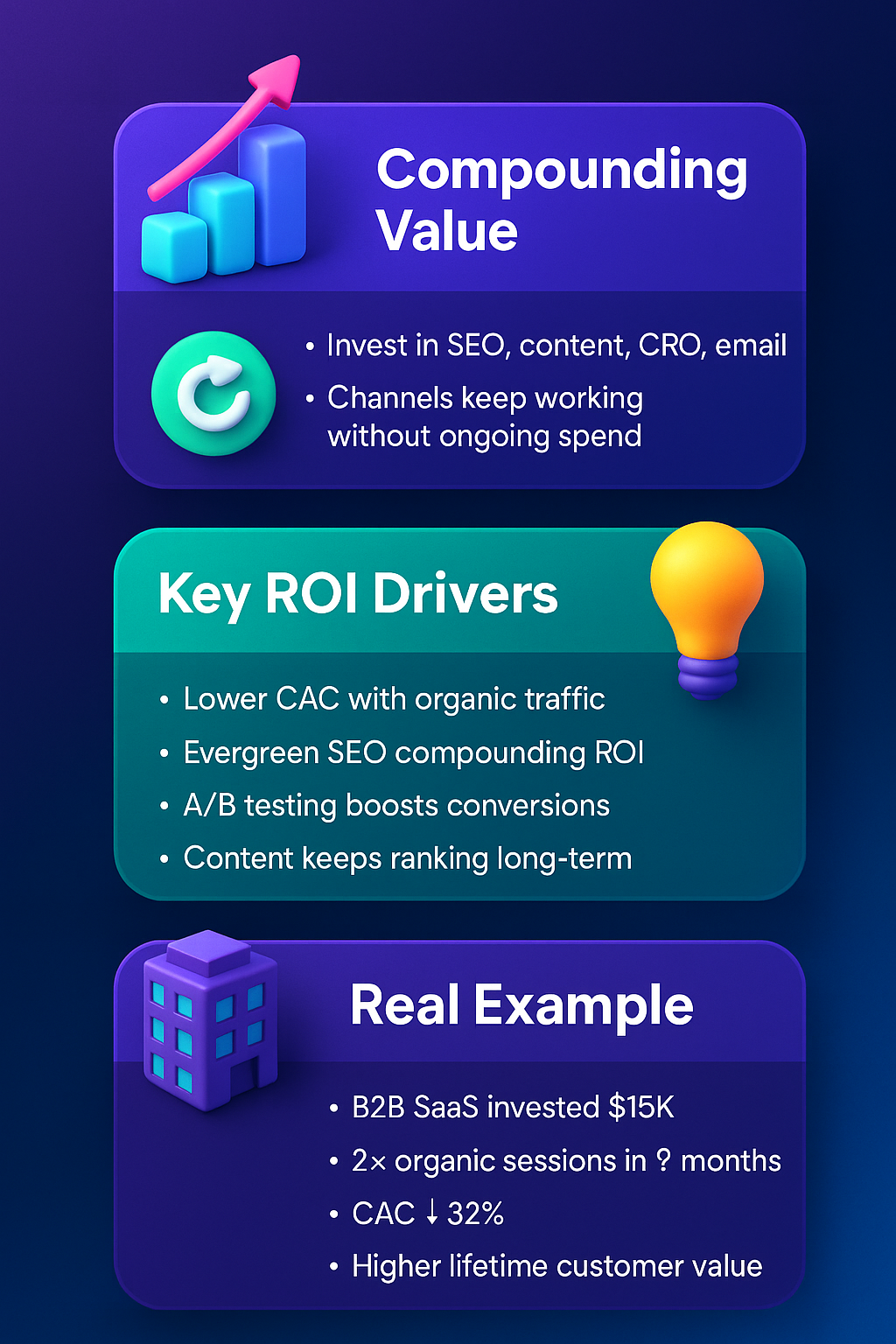
PPC ROI in 2025
PPC ROI analysis in 2025 is immediate but costly. Businesses get traffic within hours, but results end the moment ad spend stops. Rising cost per click (CPC) and higher cost per acquisition (CPA) reduce margins across industries.
Key factors shaping the ROI of PPC advertising:
Average CPC in competitive niches (finance, SaaS, law) exceeding $20–$50.
ROI heavily dependent on landing page conversion rates.
Paid ads ROI declining when competition inflates bidding wars.
Example: An e-commerce brand spending $25,000/month on PPC generated $100,000 in sales at a 4% conversion rate. ROI was strong but dropped once spending paused.
ROI Comparison: Growth Marketing vs PPC
| Factor | Growth Marketing ROI 2025 | PPC ROI 2025 |
|---|---|---|
| Timeline | Compounds after 6–12 months | Instant but stops without spend |
| Cost Per Lead | Decreases steadily with SEO + content | Rises as CPC increases |
| Lead Quality | Higher (organic, nurtured leads) | Mixed (depends on targeting) |
| ROI Benchmarks | 3–5x ROI over long term | 2–3x ROI short term |
| Sustainability | Long-term digital marketing ROI | Paid ads ROI ends once budget stops |
Key Insight
Growth marketing ROI in 2025 outperforms PPC ROI in the long term. Paid ads ROI is still helpful for short-term campaigns, but sustainable growth comes from organic channels that lower acquisition costs and build authority.
Pricing Models Explained
Pricing models for growth marketing vs PPC in 2025 vary depending on whether you hire an agency, build an in-house team, or use freelancers. Understanding how these models work helps businesses compare actual costs and avoid overspending.
Growth Marketing Pricing Models
Growth marketing agency pricing in 2025 is usually based on monthly retainers. Smaller businesses often pay between $3,000 and $7,000 per month, while mid-size companies pay $10,000 to $25,000 monthly. Enterprise-level growth marketing retainers can exceed $50,000 per month, especially when scaling across multiple markets.
Typical inclusions in growth marketing packages are:
SEO optimization and technical audits
Content creation and distribution
Conversion rate optimization
Email automation and CRM integration
Analytics, reporting, and continuous A/B testing
Some agencies also offer performance-based pricing models, where fees scale with conversions or revenue generated. This reduces upfront risk but often requires higher percentage fees.
In-house growth marketing costs differ. A dedicated team may include SEO managers, copywriters, email specialists, and analysts. Total annual costs can exceed $300,000–$500,000, excluding tools such as SEMrush, HubSpot, and automation platforms.
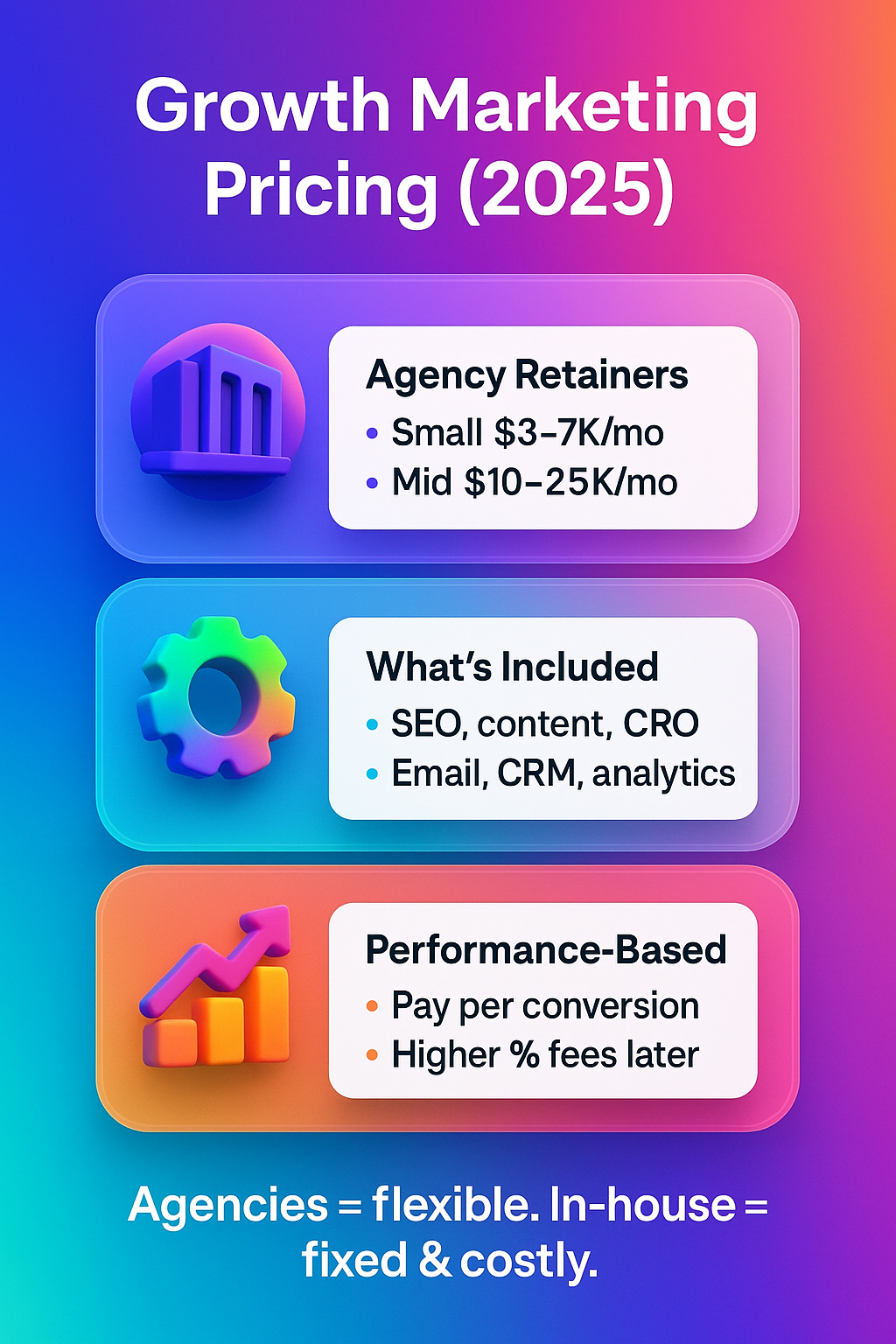
PPC Pricing Models
PPC management fees in 2025 are tied directly to ad spend. Agencies typically charge 10–20% of monthly ad budgets as a management fee. If a company spends $50,000 monthly on Google Ads, management fees alone range from $5,000–$10,000.
Common PPC pricing models include:
Flat retainers ($1,000–$5,000 per month).
Percentage of ad spend (most common).
Performance-based PPC fees, where agencies charge based on leads or sales delivered.
PPC also requires a minimum ad spend commitment, often $2,500–$5,000 monthly, making it difficult for tiny businesses.
In-House vs Agency Costs
| Option | Growth Marketing Cost 2025 | PPC Advertising Cost 2025 |
|---|---|---|
| Agency | $3,000–$50,000+ per month | 10–20% of ad spend + $2,500–$100k+ spend |
| In-House Team | $300k–$500k yearly + tools | $200k–$400k yearly + ad spend |
| Freelancers | $50–$150/hour (specialists) | $30–$100/hour (PPC experts) |
Hidden Costs of Growth Marketing vs PPC
The hidden costs of growth marketing vs PPC in 2025 are often overlooked. Businesses budget for obvious expenses but miss the extra costs that reduce ROI and increase long-term spending.
Hidden Growth Marketing Costs
While growth marketing costs appear clear, content creation, SEO tools, and automation, several hidden expenses can surprise businesses:
Content updates: Evergreen content must be refreshed to stay competitive.
A/B testing tools: Platforms like Optimizely or VWO add $300–$1,000/month.
Training costs: Teams require ongoing education to adapt to SEO algorithm updates.
Opportunity costs: Time invested in testing campaigns delays immediate results.
These hidden growth marketing expenses don’t always appear in agency proposals, but add to the total investment. Still, their long-term payoff often outweighs the upfront burden.
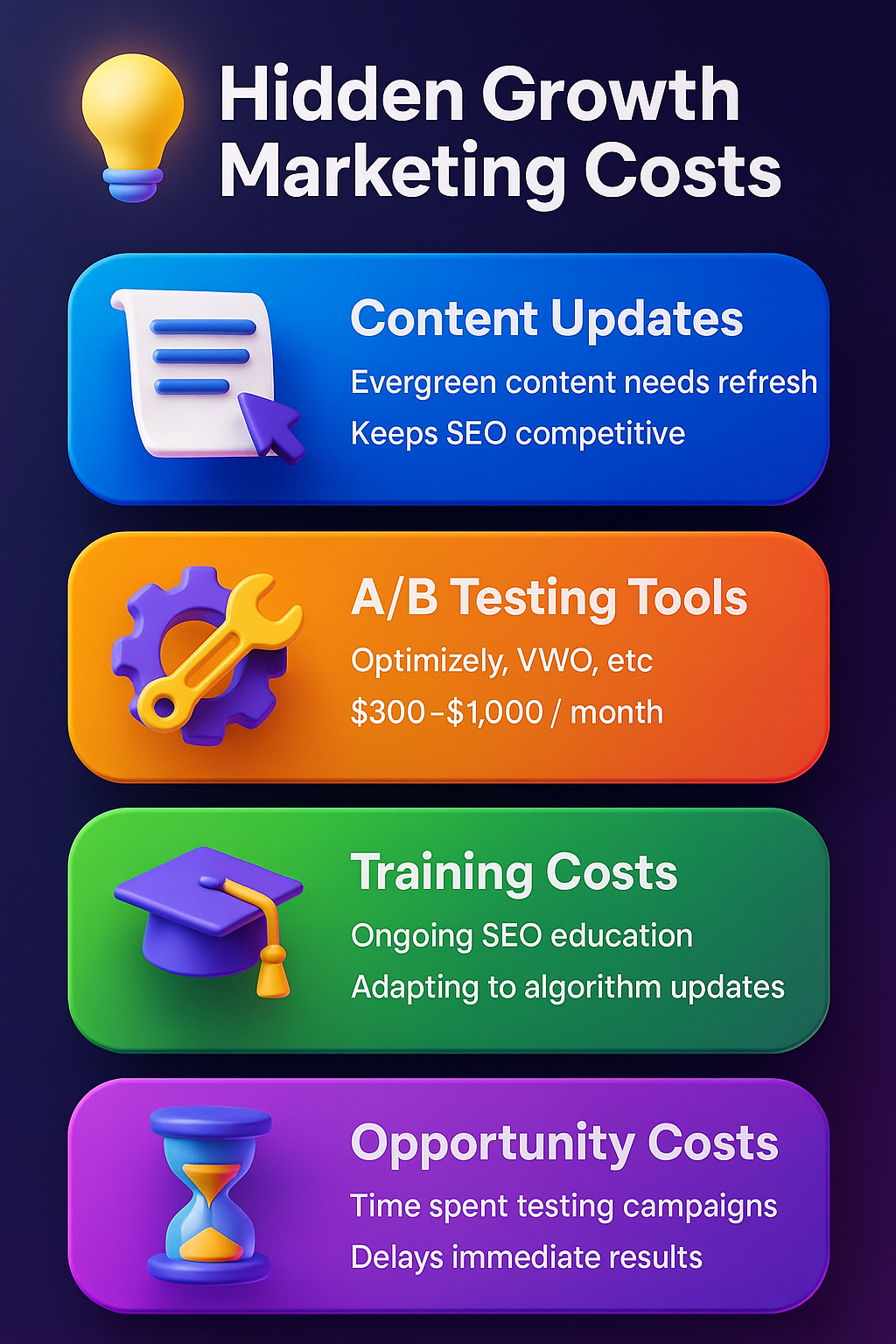
Hidden PPC Costs
Hidden PPC costs in 2025 are more dangerous because they drain budgets quickly. Wasted clicks, poor targeting, and competitive bidding can eat into ROI.
Common unexpected PPC expenses include:
Click fraud: Automated bots or competitors inflating click counts.
High CPC spikes: Rising bids in competitive industries (finance, SaaS, law).
Landing page optimization: Without CRO, even expensive clicks won’t convert.
Agency management fees: Often not included in the initial quote.
Ad fatigue: Repeated exposure lowers performance, requiring constant ad refresh.
According to Statista, global digital ad fraud is projected to cost businesses over $100 billion annually by 2025.
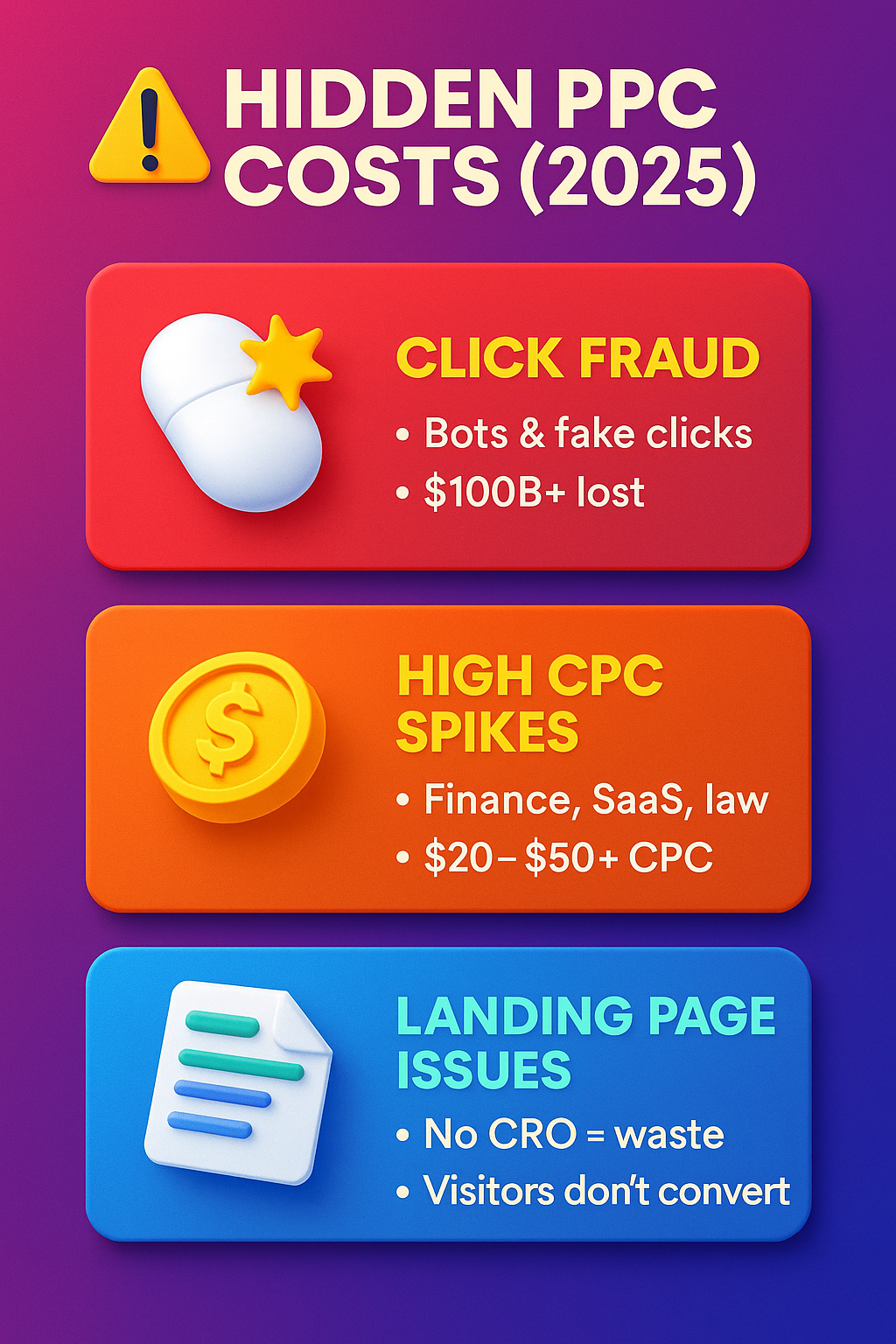
Key Takeaway
The hidden costs of growth marketing are long-term and predictable, often tied to content upkeep and tools. Hidden PPC costs are immediate, unpredictable, and can burn through budgets fast if not carefully managed.
Case Studies Comparing Growth Marketing vs PPC
Case studies of growth marketing vs PPC in 2025 show how businesses experience real costs and ROI in different scenarios. By comparing outcomes, companies can understand when to invest in long-term strategies and when PPC is the more brilliant short-term play.
Case Study 1: SaaS Company Choosing Growth Marketing
A mid-size SaaS company sought to reduce its customer acquisition cost (CAC) while scaling globally. Initially, their budget leaned heavily on PPC campaigns. With Google Ads and LinkedIn Ads, they spent $40,000 per month in ad spend plus a 15% agency management fee. The campaigns generated leads, but CAC averaged $850 per new user, unsustainable for their margins.
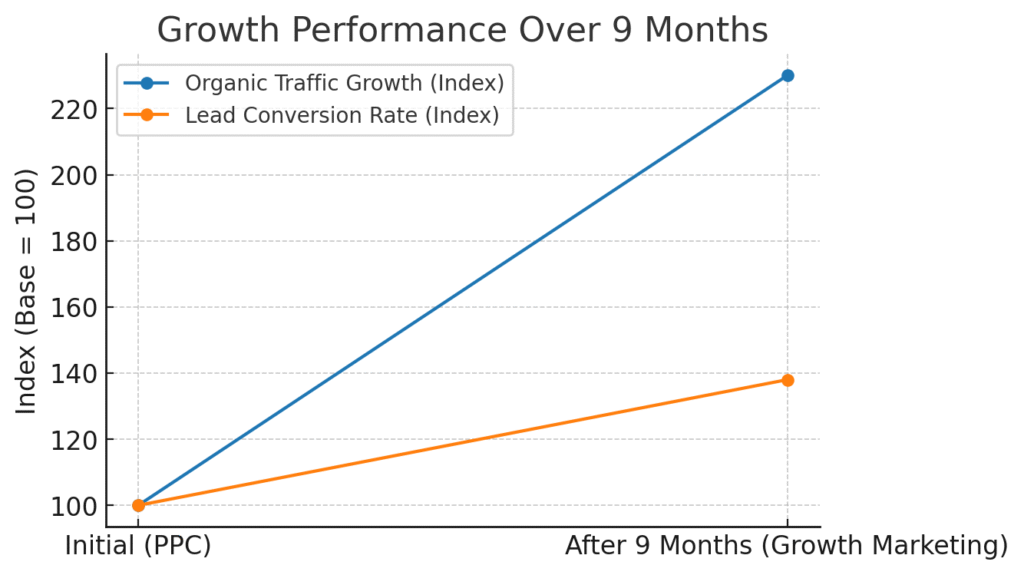
They shifted to growth marketing in 2025, investing in SEO-driven content, automated email nurturing, and CRO-focused landing page design. The upfront costs included:
$12,000 monthly retainer for growth marketing agency services.
$4,000 for content creation and technical SEO tools.
$2,000 in A/B testing and automation software.
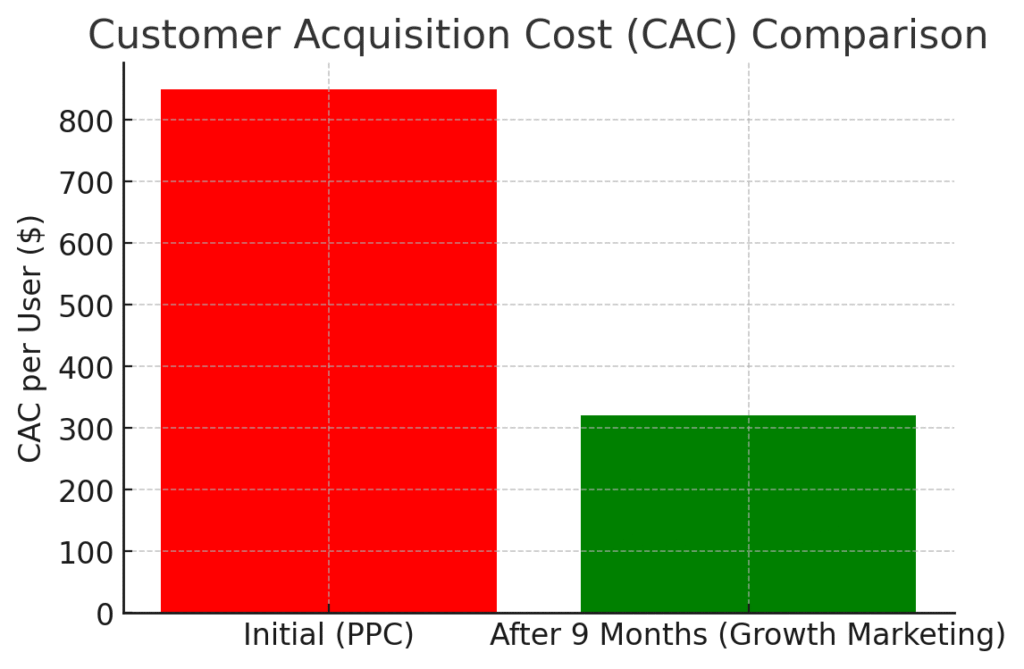
Within 9 months, organic traffic grew 130%, lead conversion improved by 38%, and CAC dropped to $320 per new user. While ROI took longer, the compounding effect reduced dependency on PPC.
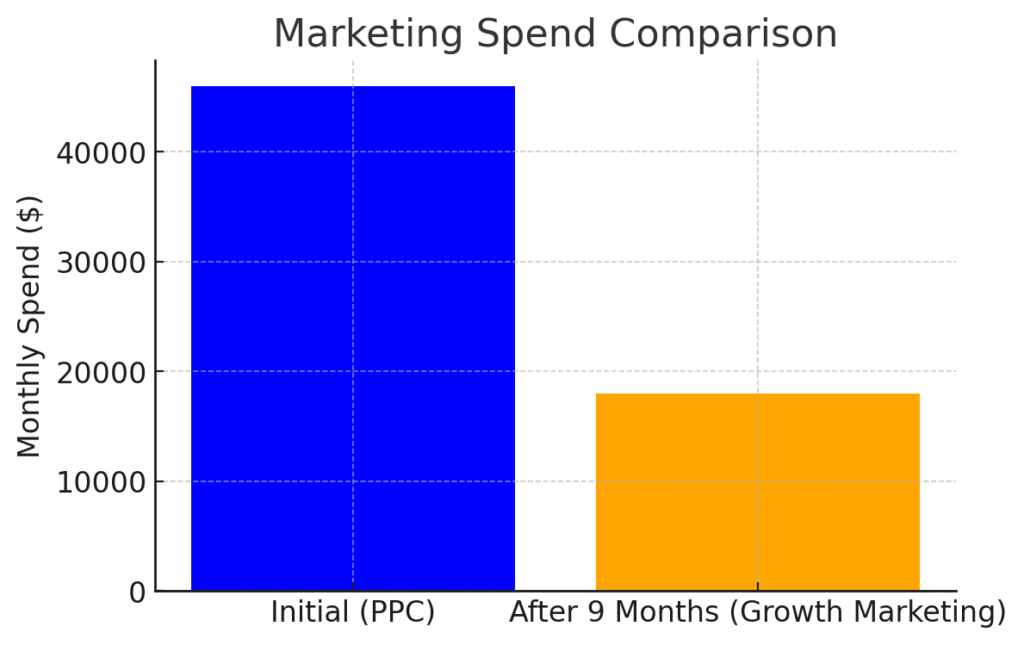
Result: Growth marketing ROI outperformed PPC by building sustainable inbound channels. CAC dropped 62%, and the company reduced PPC spend to supplement campaigns instead of relying on it.
Case Study 2: Ecommerce Brand Using PPC
An e-commerce fashion brand focused on seasonal campaigns in 2025. Instead of waiting for SEO to mature, they used PPC for instant results during product launches. Their monthly ad spend allocation looked like this:
$25,000 in Google Shopping Ads.
$10,000 in Meta Ads targeting lookalike audiences.
$5,000 agency management fee (flat retainer).
Average CPC across campaigns was $2.20, with conversion rates around 3.8%. In the first month, PPC generated $120,000 in sales, giving a strong short-term ROI.
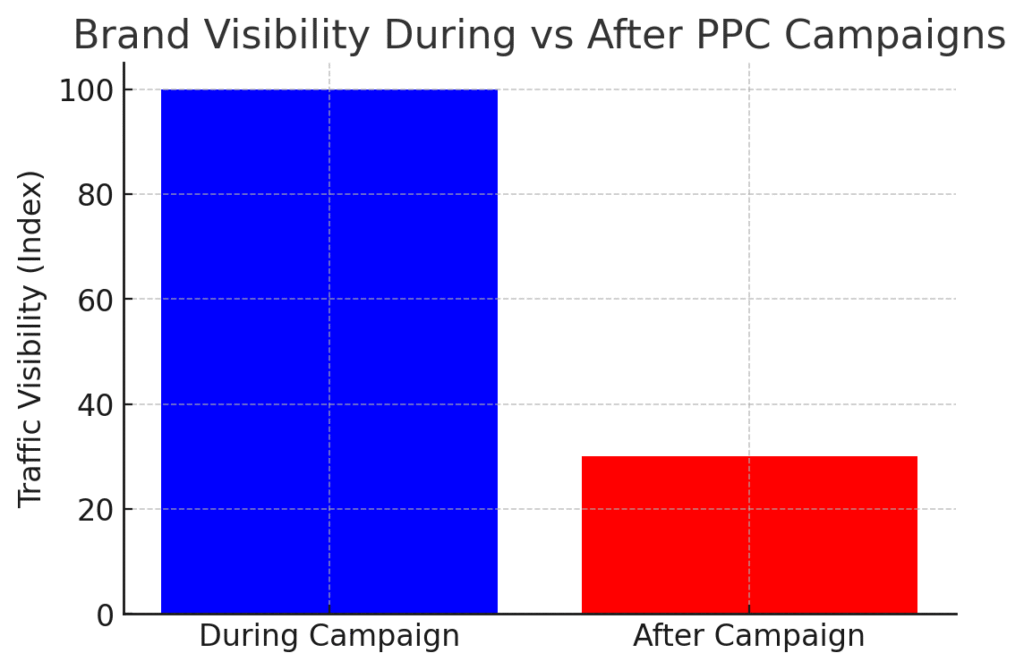
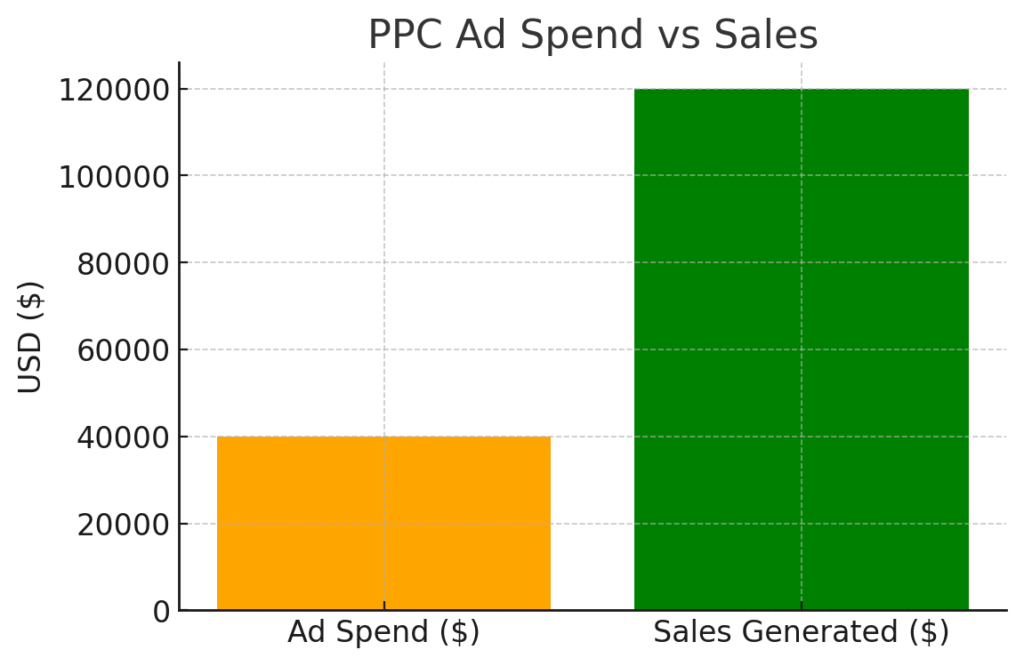
However, when campaigns paused after the season, traffic vanished. Without organic content, brand visibility dropped by 70%. They realized PPC ROI was substantial but temporary, and building a hybrid approach with growth marketing would create sustainable year-round results.
Result: PPC provided a 4.8x short-term ROI but failed to reduce CAC long-term. The brand began reinvesting part of PPC profits into growth marketing for sustainable traffic.
In-Text Comparison: Growth Marketing vs PPC Case Studies
| Factor | SaaS Company (Growth Marketing) | Ecommerce Brand (PPC) |
|---|---|---|
| Monthly Spend | $18,000 (agency + tools) | $40,000 (ads + fees) |
| Customer Acquisition Cost (CAC) | $320 after 9 months | $450–$600 per order |
| ROI Timeline | 9 months to scale | Immediate but seasonal |
| Sustainability | High (evergreen content + automation) | Low (traffic stops when ads stop) |
| Long-Term Value | Compounding traffic + authority | Short-term boosts, no lasting effect |
Future Trends in Growth Marketing and PPC (2025–2030)
The future of growth marketing vs PPC from 2025 to 2030 will define how businesses invest in digital channels. With rising costs and new technologies, strategies must adapt to remain profitable.
Growth Marketing Trends 2025–2030
Growth marketing trends point to heavier use of AI, automation, and predictive analytics. Companies will focus on AI-powered SEO tools, conversion rate optimization, and content marketing ROI through video, interactive media, and personalization. As global expansion accelerates, multilingual content and international growth marketing strategies will dominate. By 2030, growth marketing ROI could outpace PPC by over 3x due to lower CAC and compounding organic visibility.
Future of PPC Advertising
PPC advertising in 2025–2030 faces higher costs. Average CPC is projected to rise 20–30%, making PPC ROI harder to sustain. AI-driven smart bidding will help optimize spend, but privacy restrictions and cookie loss will weaken targeting. Retargeting PPC will still be valuable but expensive, especially for small businesses with limited budgets.
Business Outlook
The balance will shift: growth marketing ROI 2030 will dominate long-term strategies, while the future of PPC advertising will stay strong for immediate visibility. Businesses that build hybrid strategies – using PPC for product launches and growth marketing for sustainable inbound traffic – will see the best digital marketing ROI.
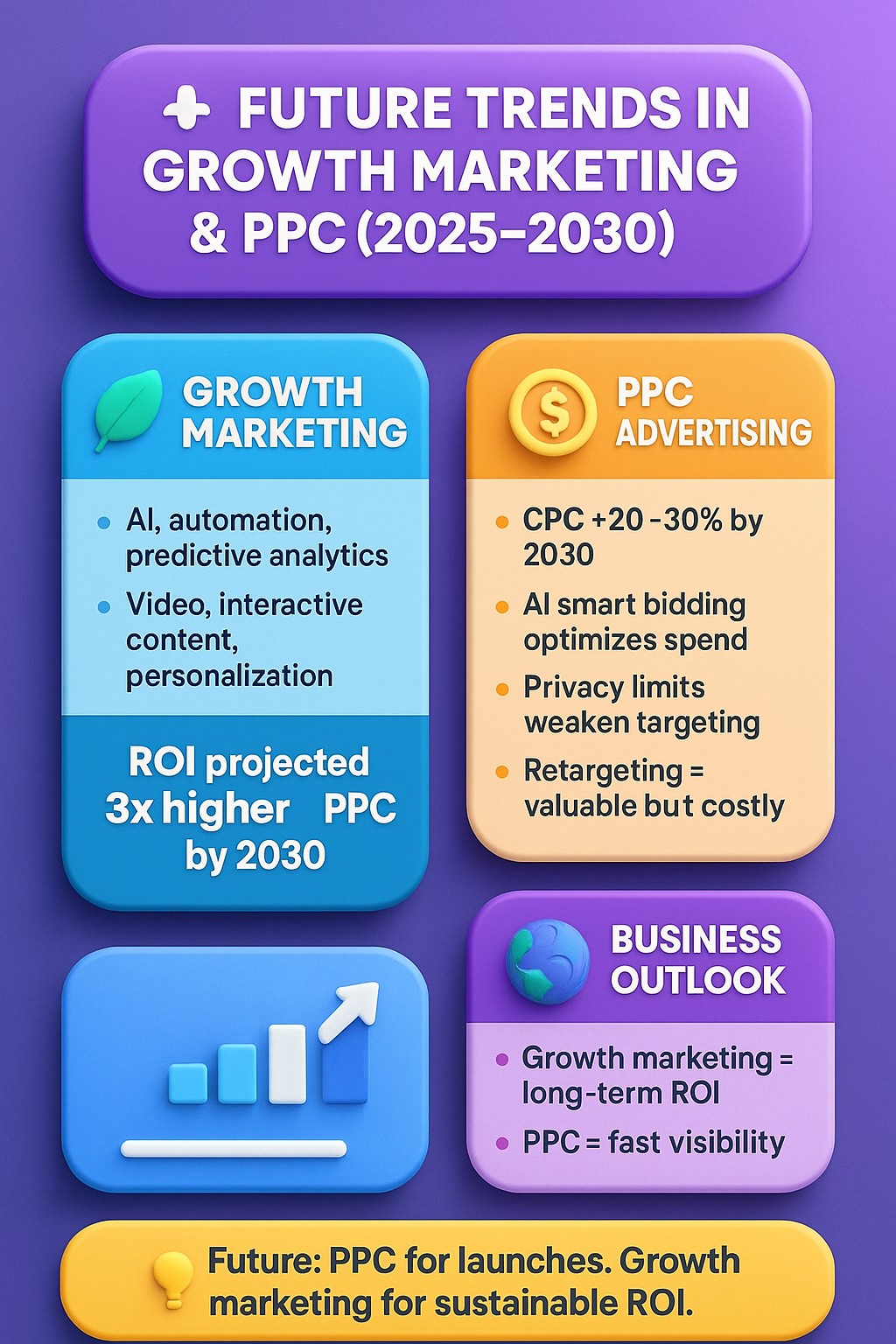
Agency Comparisons and aboveA Positioning
Comparing growth marketing agencies vs PPC agencies in 2025 helps businesses understand what they truly pay for. Costs, services, and ROI differ widely. By evaluating options side by side, decision-makers can see where long-term investments create the most value.
Agency Comparison: Growth Marketing vs PPC
Below is a comparison of 10 leading agencies in 2025, showcasing pricing, focus areas, and ROI expectations.
| Agency | Focus Area | Avg. Monthly Cost (2025) | ROI Outlook (2025) | Notes |
|---|---|---|---|---|
| aboveA | Growth Marketing + SEO | $8k–$20k | 3–5x over 12 months | Specializes in international expansion + compounding ROI. |
| Ignite Visibility | PPC + SEO | $10k–$25k | 2–4x ROI, faster PPC results | Strong for ad-heavy strategies. |
| WebFX | Full-Service Digital | $7k–$30k | 2–4x ROI | Scalable packages, mixed organic/PPC focus. |
| Disruptive Advertising | PPC + CRO | $12k–$35k | 2–3x ROI | Known for rapid PPC scaling. |
| Single Grain | Growth + Paid Media | $15k–$40k | 3–5x ROI | Strong in SaaS and tech. |
| Victorious | SEO-Only Growth | $5k–$15k | 3–6x ROI over 12 months | Focused entirely on organic strategies. |
| Directive | B2B SaaS Growth Marketing | $12k–$30k | 3–4x ROI | Good for SaaS verticals. |
| Titan Growth | Paid Media + SEO | $8k–$25k | 2–4x ROI | Balanced but PPC-heavy. |
| SmartSites | PPC + Web Design | $6k–$20k | 2–3x ROI | Good entry-level PPC campaigns. |
| NP Digital | Enterprise SEO + Paid Ads | $20k–$75k | 3–5x ROI | Best for enterprise-level campaigns. |
aboveA Positioning
aboveA stands out in 2025 by prioritizing growth marketing ROI over short-term PPC wins. Unlike many agencies that lock clients into high ad spends, aboveA reduces CAC through SEO, conversion design, and automation. The agency specializes in international SEO and market entry strategies, making it ideal for startups and scaling businesses seeking sustainable growth.
Where competitors push ad budgets higher, aboveA builds compounding assets that keep driving leads – even when ad spend stops.
Conclusion
The real cost of growth marketing vs PPC in 2025 depends on your goals and timeline. PPC delivers fast results but at higher ongoing costs, while growth marketing builds compounding ROI that lowers acquisition costs over time. Businesses chasing quick wins often overspend on ads, while those investing in sustainable strategies gain lasting authority, stronger conversions, and long-term profitability.
The future of digital marketing lies in a hybrid approach, leveraging PPC for short-term campaigns and growth marketing for continuous inbound growth. Companies choosing a balance will outperform competitors and secure a stable path to revenue expansion.
Meet the Author

Faustas Norvaisa
A Growth & Product Expert with 9 years of experience in revenue diversification, international expansion, SEO, and digital marketing. Passionate about scaling businesses and building global brands, he empowers companies to thrive with his motto, "sharing is caring.

